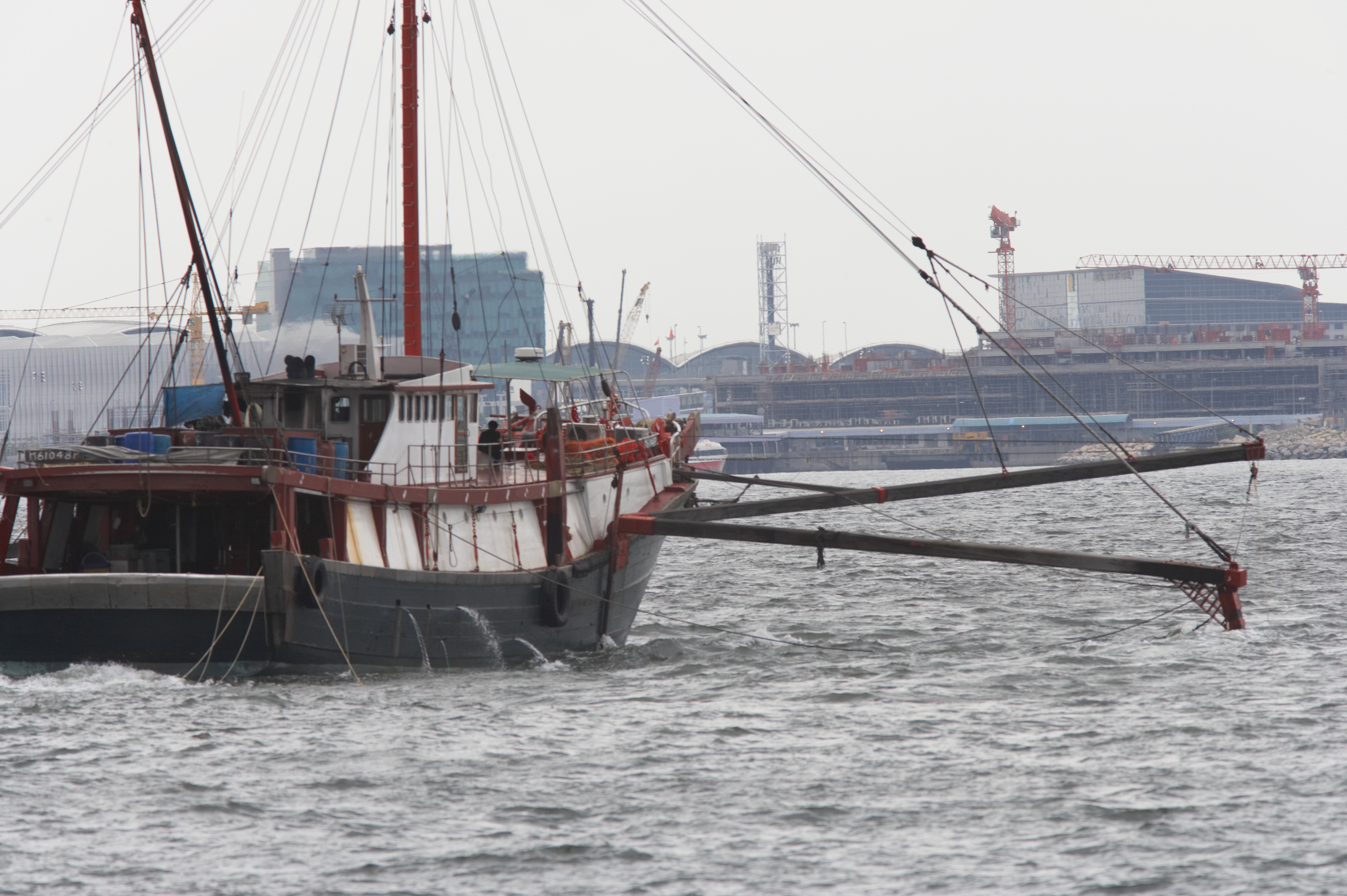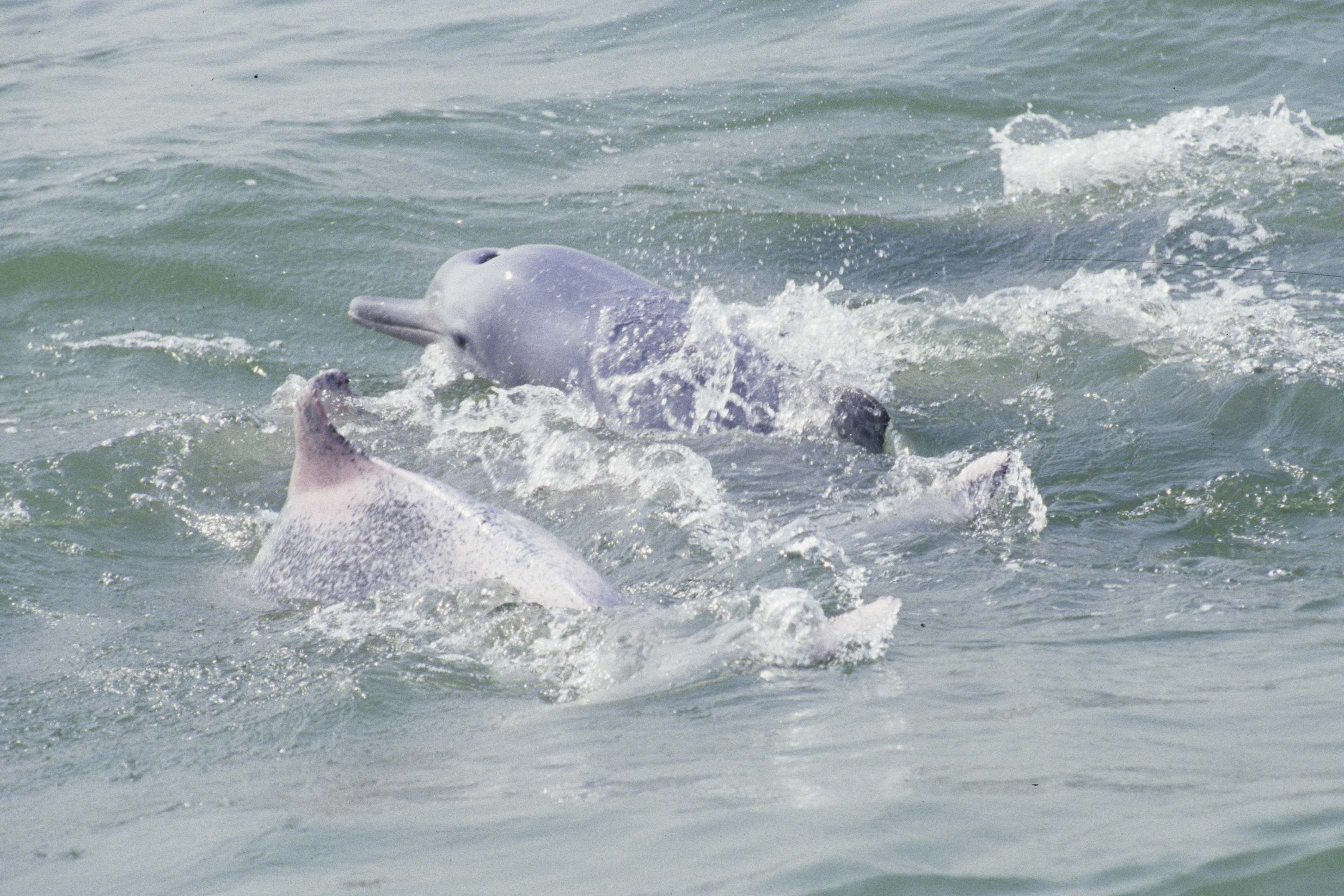The WWF is run at a local level by the following offices...
- WWF Global
- Adria
- Argentina
- Armenia
- AsiaPacific
- Australia
- Austria
- Azerbaijan
- Belgium
- Bhutan
- Bolivia
- Borneo
- Brazil
- Bulgaria
- Cambodia
- Cameroon
- Canada
- Caucasus
- Central African Republic
- Central America
- Central Asia
- Chile
- China
- Colombia
- Croatia
- Democratic Republic of the Congo
- Denmark
- Ecuador
- European Policy Office
- Finland
There are many reasons why the Chinese white dolphin (Sousa chinensis) is beloved by the Hong Kong people. At the top of the list: its pink colouring and its friendly nature.
The Chinese white dolphin was first recorded in local waters as early as the 1600s. The dolphins’ habitat spans the Pearl River Estuary, and is closely associated with the estuarine mixing zone between the river and the ocean.
On the western coast of the Pearl River Estuary, within Hong Kong waters, the dolphins prefer to stay close to the shore. In particular, they are known to be in North Lantau waters near Castle Peak, Lung Kwu Chau and Sha Chau Marine Park, Chek Lap Kok and Tai O. They are also found in the waters south of Lantau, including Fan Lau and the Soko Islands.
The population inhabiting the Pearl River Estuary, including Hong Kong, is believed to number around 2,500 individuals. During the past few years, there has been a worrisome decrease in the number of young dolphins sighted in Hong Kong waters. These lower numbers could result in a decrease in the population in years to come.
In recent years, the Chinese white dolphin has been facing a number of threats: overfishing, water pollution and heavy marine traffic, along with coastal development. These threats have had a major and cumulative impact on the population for years. It is necessary to take a proactive approach in order to conserve the remaining population of the species before it’s too late.

Dolphins are closely related to whales and porpoises, and all belong to the same group called the Cetaceans.
Common name
Species name
Global conservation status
Protection status
Listed in the Convention on International Trade in Endangered Species of Wild Fauna and Flora (CITES) Appendix I. Appendix I includes species threatened with extinction. Trade in specimens of these species is permitted only in exceptional circumstances.
Listed in the Convention on Migratory Species (CMS) Appendix II. Migratory species that have an unfavourable conservation status or would benefit significantly from international co-operation are listed in Appendix II.
China
Listed as a “Grade 1 National Key Protected Species” in mainland China.
Hong Kong
Protected under Wild Animals Protection Ordinance (Cap 170) and Protection of Endangered Species of Animals and Plant Ordinance (Cap 586).
Sha Chau and Lung Kwu Chau Marine Park was designated in 1996, aiming to protect one of the most important habitats of Chinese white dolphins in Hong Kong. However, a number of their habitats recognised as important in Hong Kong are not legally protected.
Population distribution
There are only 32 individuals in Hong Kong. Its population size remains stable but threats continue to be serious and are mounting.
Resident populations of the Chinese white dolphin can be found year-round in the western waters of Hong Kong, particularly in north Lantau waters near Castle Peak, Sha Chau and Lung Kwu Chau Marine Park, Chek Lap Kok and Tai O. A number of them can also be found in the waters of south of Lantau – near Fan Lau and the Soko Islands. Among these areas, only Sha Chau and Lung Kwu Chau were designated at marine park to provide protection to this beloved marine mammal species.
The population of the Chinese white dolphins in the Pearl River Estuary (PRE) is very unique. Not only is it the largest one that remains along China’s coastline, it also inhabits one of the world’s most congested areas that has very heavy marine traffic and serious water pollution problems. The dolphins that inhabit these areas are under enormous pressure. Due to a series of development projects, they are facing severe man-made threats that have resulted in habitat loss and degradation.
 © Adam Minu
© Adam Minu
Since the mid-90s, more than 1,400 hectares of sea area have been reclaimed in Hong Kong’s western waters. This is within the relatively small area inhabited by the dolphins. In addition to a direct loss of the dolphin’s habitats, reclamation has affected fishery resources, which subsequently leads to a decrease in food supply for the dolphins. The threats to our vulnerable marine ecosystem don’t end with reclamation. Additional threats include past, present and future works on dredging; dumping; and facilities installation. As well, the impacts from water and noise pollution, and an increase in vessel traffic, play a role in destroying the habitat.
Agriculture, Fisheries and Conservation Department (AFCD) has a Chinese white dolphin conservation programme and action plan. However, apart from conducting a long-term monitoring programme, progress is limited to implementing the conservation measures identified when plan was formulated back in 2000. For instance, although the Sha Chau and Lung Kwu Chau Marine Park, the so called “dolphin sanctuary,” is a key component of this conservation plan, its effectiveness may be limited as the area is not truly protected from development and habitat modification. The marine park should also provide increased feeding opportunities for the Chinese white dolphin population by allowing fish and other food stocks to increase. Commercial fishing under permit is still allowed within the marine park, however, so the dolphins are competing with fishermen for food. After all, at least three important habitats for the dolphins are not receiving any statutory protection.
- Habitat loss from coastal development
Chinese white dolphins typically feed in shallow coastal areas up to a depth rarely exceeding 10 metres. Extensive reclamation for many past, current and future projects such as the Hong Kong International Airport, Hong Kong-Zhuhai-Macao Bridge, and the third airport runway is physically reducing the recognized dolphin important habitats. This adds a stress upon the dolphin population, forcing them to move farther away, possibly towards less suitable habitats. Habitat loss from rampant coastal development directly results in the loss and disturbance of the Chinese white dolphin’s breeding, nursery and foraging grounds. Reclamation may also block or affect movement between important habitats. - Water pollution
The amount of suspended solids in the water column elevates during the dredging process. An increase in suspended solids raises the risk of clogging fish gills. As well, it reduces growth rates and prevents egg and larval development. Fish and some crustaceans are known to be the major food source of dolphins; an increase in sediment will subsequently lower the amount of food available for the dolphins and threaten the food chain. The dredging works may also lower the dissolved oxygen concentration in the water column, causing death of the fish and also resulting in a reduction in the food source available to Chinese white dolphins.
The dumping work at the contaminated mud pits, namely the existing East Sha Chau facility and the future South Brothers facility, may also pose adverse impacts to the Chinese white dolphin habitats in the surrounding areas. Pollutants such as organochlorines and heavy metals from the contaminated mud will dissolve into the water column and accumulate in dolphins’ bodies, which are considered potentially health threatening for the Chinese white dolphin.
The Chinese white dolphin has also suffered from the regional water pollution of the PRE. However, the overall impacts of water pollution to dolphin are remained unclear and more research is required.
- Underwater noise pollution
Dolphins rely on echolocation, which is similar to sonar, for hunting, communication and navigation. The dolphins listen to the reflected sound they produce and use this to locate their peers, fish and other objects. Underwater construction works sometimes involve techniques such as percussive piling (which will be used for constructing the foundation of wind turbines in south Lamma), which may interfere with the dolphins’ echolocation capability. In extreme cases, this will result in death for the affected dolphins.
The increasing marine traffic also poses threats of obscuring sounds and acoustic communication, also interfering with echolocation. High levels of boat noise can lead to injuries or disturbance, as manifested by changes in behaviour and use of acoustic signalling.
- Vessel collision
In Hong Kong, the waters have become more congested due to reclamation, and marine traffic is also getting busier. There are many high-speed ferries running between Hong Kong, Macau and other cites in the Pearl River area everyday. The marine traffic has increased in western waters, doubling from 1999 to 2009. The current high-speed ferry routes transverse the prime dolphin habitats around Lantau waters, increasing the risk of dolphins being hit and causing injuries. Scars and marks, possibly caused by the vessel propellers, can sometimes be observed on the fins or bodies of the Chinese white dolphin.
- Over-fishing
In Hong Kong, there are no regulations in place to control fishing efforts or the available catch. A continued decline in fisheries resources have been observed. Local catch composition has changed from mainly large, slow-growing, high-value species, to small, fast-growing, low-value species. In additional to over-fishing, certain fishing practises are also not sustainable. For instance, the seabed is continually disturbed by bottom trawling. The decline in fisheries resources will cause reduction in food supply to the dolphins.
 © Alan Leung
© Alan LeungThe cause of death for most of these individuals is largely unknown, although entanglements with fishing gear, injury from vessels and high pollution levels have been responsible for several deaths. The majority of deaths are of young or newborn dolphins.
Below is the number of Chinese white dolphins stranded between 2000-2009:
| Year | No. of Chinese White Dolphin strandings |
|---|---|
| 2000 | 10 |
| 2001 | 8 |
| 2002 | 7 |
| 2003 | 14 |
| 2004 | 10 |
| 2005 | 13 |
| 2006 | 5 |
| 2007 | 17 |
| 2008 | 10 |
| 2009 | 8 |
WWF is deeply concerned with the cumulative impacts from habitat loss and disturbance from previous and upcoming developments. Many other existing or upcoming development projects involve dredging, dumping and reclamation etc. These threats, combined with a cocktail of other threats and challenges, are definitely a danger to the Chinese white dolphin, which need to inhabit the remaining limited water areas in order to survive.
Major development projects causing permanent loss of Chinese white dolphin habitats in Hong Kong western waters include:
| Projects | Area (ha) |
|---|---|
| Tung Chung Development | 128 |
| Lantau Link Project & North Lantau Highway | ~ 30 |
| Hong Kong International Airport | 938 |
| Tuen Mun Area 38 | 61 |
| Penny's Bay Development | 280 |
| Tai O Development Plan | 12.8 |
| Hong Kong-Zhuhai-Macao Bridge - Link Road & Boundary Crossing Facilities | >130 |
| Lantau Logistics Park | 130 |
| Hong Kong Airport Third Runway | >300 |
Major development projects causing disturbance to seabed in Chinese white dolphin habitats in Hong Kong western waters:
| Projects | Area (ha) |
|---|---|
| East Sha Chau Contaminated Mud Pit Facility | >300 |
| South Brothers Contaminated Mud Pit Facility | 153 |
The current environmental impact assessment (EIA) process fails to effectively address the cumulative impacts of multiple development projects on Chinese white dolphins.
Policy Advocacy
- WWF-Hong Kong intends to initiate cross-boundary collaboration with mainland authorities on conservation of the Chinese white dolphin. As well, we are advocating for the formulation of a cross-border Chinese white dolphin Conservation Action Plan that encompasses management measures for the entire Pearl River Estuary, including the collaboration among adjacent authorities.
- We will urge the Hong Kong Government to implement the designation of Southwest Lantau and Soko Islands Marine Park, an outstanding 2002 proposal to protect the important dolphin habitats. We will also monitor the progress of the designation of The Brothers Islands Marine Park, which is a proposed compensation due to the construction of the Hong Kong-Zhuhai-Macao Bridge.
- We are advocating for a review the current mechanism in the environmental impact assessment process in Hong Kong. We wish to ensure the assessment of cumulative impacts are fully evaluated and addressed by each project proponent for the future infrastructure projects that may encroach on dolphin habitats.
- We are also advocating for a comprehensive Strategic Environmental Assessment for the Hong Kong western waters. This should be conducted by the Government to ensure developments are avoiding ecologically sensitive areas, such as the habitats for the Chinese white dolphins and other species of conservation importance, such as horseshoe crabs and seagrass bed.
- We are supporting the introduction of sustainable fisheries management through the Save Our Seas (SOS) campaign. The goal is to reduce the threats of decreasing food supply for marine mammals.
Reducing Impacts from Developments
- We are providing comments and suggestions so that potential environmental impacts can be avoided, reduced and mitigated using best practices, in order to ensure any possible impact on the dolphin habitats is kept to the minimum.
- We are striving to ensure cumulative impacts from developments in environmentally sensitive areas are adequately addressed.
- We will campaign for greater dolphin protection in response to major infrastructure developments.
Research and seminar
The panel made 25 recommendations from this workshop. They are now acting as WWF’s roadmap to ultimately contribute to the formulation and implementation of a science-based cross-boundary Chinese white dolphin management plan. A number of research based on several of the recommendations have been completed or are ongoing, including the research started in 2010 in the south of China.
Since early 2010, WWF has been working with two mainland scientific institutes, South China Sea Fisheries Research Institute (SCSFRI) and Third Institute of Oceanography, to conduct a one-year Chinese white dolphin study in the south of China. The study aims to investigate the distribution, abundance and habitat use of the Chinese white dolphin in the western extent of Pearl River Estuary (PRE) areas through vessel surveys. As well, the institutes are interviewing fisherman in order to collect information related to the occurrence of Chinese white dolphins along the coast from PRE to Xiamen.
Information obtained from the survey will help fill in the data gaps in knowledge for the extent of dolphin population in western part of the PRE. This is essential for developing future conservation management. Click here to know the research details.

In 2006, China Light and Power (CLP) announced plans to build a Liquefied Natural Gas (LNG) Receiving Terminal at South Soko Island, which is one of the most frequently used habitats of the Chinese white dolphin in Hong Kong. WWF engaged in extensive dialogue with the Hong Kong government and launched a campaign to help make the public aware of this threat. Over 20,000 signatures supporting WWF’s petition were submitted during the environmental impact assessment public consultation period. In September 2008, CLP announced its decision to stop the LNG Terminal project at the Soko Islands.
In China, historical sightings tell us that the species used to extend from the East China Sea, near Shanghai, to the Gulf of Tonkin in southernmost China. China coastal area has been greatly modified in the last few decades, and its marine resources have been depleted and degraded. Today, distribution has shrunk along the coast of mainland China and only five populations are known to remain in east and northern South China Sea;
- the Jiulong River, Xiamen (Fujian Province),
- the Pearl River Estuary, Hong Kong and Zhuhai (Guangdong Province),
- Sanniang Bay, Beihei (Guangxi Province),
- Zhanjiang Bay, Leizhou (Guangdong Province) and,
- Jhuoshuei and Daan Rivers, between Miaoli and Tainan Counties (Taiwan) [this subpopulation was listed as critically endangered by the World Conservation Union (IUCN) in August 2008]
This project, generously funded by Shiseido – AUPRES, will promote academic exchange between marine mammal researchers from throughout China, will assist regional conservation efforts for Chinese white dolphins and will also increase public awareness on the plight of this extra-ordinary pink dolphin.

Researches on Chinese White Dolphin
Since early 2010, WWF has been contracting two mainland scientific institutes, namely South China Sea Fisheries Research Institute (SCSFRI) and Third Institute of Oceanography (TIO) for the conduction of a one-year Chinese white dolphin (CWD) study in the south of China. Data on distribution, abundance and habitat use of CWD in the western extent of Pearl River Estuary areas (WPRE) through vessel surveys, as well as those information related to CWD occurrence along the coast from Xiamen to PRE through fishermen interviews have been collected. Using both line transect and photo-identification techniques, WWF hope to understand more of this species latest population size, distribution and status.
 Aupres dolphin watching trip at Tai O, 15 September 2010
Aupres dolphin watching trip at Tai O, 15 September 2010